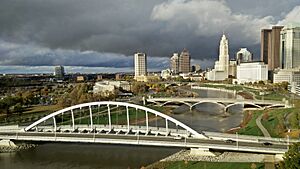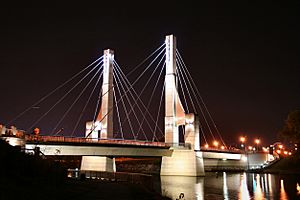Geography of Columbus, Ohio facts for kids
The city of Columbus is in central Ohio. It sits where the Scioto and Olentangy rivers meet. The area has a humid continental climate. This means it has hot, sticky summers and cold, dry winters.
Contents
Land and Rivers

Columbus is a big city, covering about 220 square miles (570 square kilometers) of land. It's one of the fastest-growing large cities in the U.S., especially in the Midwest. This is because Columbus often adds nearby areas to its city limits. This helps the city keep growing and stay strong economically.
Some of the large towns near Columbus are Westerville, Gahanna, Reynoldsburg, Grove City, Upper Arlington, Hilliard, and Dublin.
The Scioto and Olentangy rivers join together just west of downtown Columbus. Other smaller streams flow through the area, like Alum Creek and Big Walnut Creek. Columbus is mostly flat because a huge glacier once covered Ohio during the Ice Age. However, there are some hills and valleys, especially near the rivers.
You'll find many Deciduous trees here, like maple, oak, hickory, and the famous buckeye tree.
Weather and Climate
| Weather chart for Columbus | |||||||||||||||||||||||||||||||||||||||||||||||
|---|---|---|---|---|---|---|---|---|---|---|---|---|---|---|---|---|---|---|---|---|---|---|---|---|---|---|---|---|---|---|---|---|---|---|---|---|---|---|---|---|---|---|---|---|---|---|---|
| J | F | M | A | M | J | J | A | S | O | N | D | ||||||||||||||||||||||||||||||||||||
|
2.7
37
23
|
2.3
41
25
|
3
51
33
|
3.4
63
43
|
4.2
73
52
|
4
82
62
|
4.8
85
65
|
3.3
84
64
|
2.8
77
56
|
2.6
65
45
|
3.2
53
36
|
3
40
27
|
||||||||||||||||||||||||||||||||||||
| temperatures in °F precipitation totals in inches source: NOAA |
|||||||||||||||||||||||||||||||||||||||||||||||
|
Metric conversion
|
|||||||||||||||||||||||||||||||||||||||||||||||
Columbus has a humid continental climate. This means it has hot, humid summers and cold, usually dry winters.
In January, the average temperature is about 29.6°F (-1.3°C). In July, it's much warmer, averaging 75.2°F (24°C). Spring and autumn are usually mild and wet. On average, temperatures reach 90°F (32°C) about 18 days a year. They drop to 0°F (-18°C) about 3 nights a year.
Columbus gets about 39.3 inches (998 mm) of rain each year. July is usually the wettest month. Snowfall averages about 28.1 inches (71 cm) per winter. Snow usually starts falling around November 21 and stops by March 31.
The hottest temperature ever recorded in Columbus was 106°F (41°C) in the 1930s. The coldest was -22°F (-30°C) in 1994.
Columbus can experience severe weather. This includes strong thunderstorms that can sometimes bring tornadoes. Floods and heavy snowstorms (blizzards) can also happen.
| Climate data for Columbus, Ohio (Port Columbus Int'l), 1981–2010 normals, extremes 1878–present | |||||||||||||
|---|---|---|---|---|---|---|---|---|---|---|---|---|---|
| Month | Jan | Feb | Mar | Apr | May | Jun | Jul | Aug | Sep | Oct | Nov | Dec | Year |
| Record high °F (°C) | 74 (23) |
78 (26) |
85 (29) |
90 (32) |
96 (36) |
102 (39) |
106 (41) |
103 (39) |
100 (38) |
91 (33) |
80 (27) |
76 (24) |
106 (41) |
| Mean maximum °F (°C) | 58.7 (14.8) |
63.3 (17.4) |
74.8 (23.8) |
82.2 (27.9) |
87.1 (30.6) |
92.2 (33.4) |
93.5 (34.2) |
92.7 (33.7) |
89.3 (31.8) |
82.1 (27.8) |
71.4 (21.9) |
61.3 (16.3) |
94.9 (34.9) |
| Mean daily maximum °F (°C) | 36.5 (2.5) |
40.6 (4.8) |
51.1 (10.6) |
63.5 (17.5) |
72.9 (22.7) |
81.6 (27.6) |
84.9 (29.4) |
83.7 (28.7) |
77.0 (25.0) |
65.1 (18.4) |
52.6 (11.4) |
40.1 (4.5) |
62.6 (17.0) |
| Mean daily minimum °F (°C) | 22.6 (−5.2) |
25.0 (−3.9) |
32.7 (0.4) |
42.6 (5.9) |
52.2 (11.2) |
61.5 (16.4) |
65.5 (18.6) |
64.1 (17.8) |
56.5 (13.6) |
45.0 (7.2) |
36.1 (2.3) |
26.8 (−2.9) |
44.3 (6.8) |
| Mean minimum °F (°C) | 0.8 (−17.3) |
5.5 (−14.7) |
13.8 (−10.1) |
26.0 (−3.3) |
36.9 (2.7) |
47.2 (8.4) |
53.0 (11.7) |
52.3 (11.3) |
40.6 (4.8) |
29.9 (−1.2) |
20.4 (−6.4) |
7.4 (−13.7) |
−3.4 (−19.7) |
| Record low °F (°C) | −22 (−30) |
−20 (−29) |
−6 (−21) |
14 (−10) |
25 (−4) |
35 (2) |
43 (6) |
39 (4) |
31 (−1) |
17 (−8) |
−5 (−21) |
−17 (−27) |
−22 (−30) |
| Average precipitation inches (mm) | 2.73 (69) |
2.25 (57) |
3.02 (77) |
3.40 (86) |
4.17 (106) |
4.01 (102) |
4.79 (122) |
3.32 (84) |
2.84 (72) |
2.61 (66) |
3.20 (81) |
2.97 (75) |
39.31 (998) |
| Average snowfall inches (cm) | 9.2 (23) |
6.1 (15) |
4.2 (11) |
1.1 (2.8) |
trace | 0 (0) |
0 (0) |
0 (0) |
0 (0) |
0.2 (0.51) |
0.9 (2.3) |
5.0 (13) |
26.7 (68) |
| Average precipitation days (≥ 0.01 in) | 14.0 | 11.4 | 12.8 | 13.7 | 13.9 | 11.2 | 10.6 | 9.2 | 8.4 | 9.4 | 11.4 | 13.2 | 139.2 |
| Average snowy days (≥ 0.1 in) | 9.1 | 6.6 | 4.5 | 1.2 | 0 | 0 | 0 | 0 | 0 | 0.1 | 1.8 | 6.5 | 29.8 |
| Average relative humidity (%) | 71.4 | 69.5 | 64.5 | 62.5 | 66.5 | 68.5 | 70.6 | 72.8 | 72.8 | 69.3 | 71.8 | 74.1 | 69.5 |
| Mean monthly sunshine hours | 110.6 | 126.3 | 162.0 | 201.8 | 243.4 | 258.1 | 260.9 | 235.9 | 212.0 | 183.1 | 104.2 | 84.3 | 2,182.6 |
| Percent possible sunshine | 37 | 42 | 44 | 51 | 55 | 57 | 57 | 56 | 57 | 53 | 35 | 29 | 49 |
| Source: NOAA (sun 1961–1990) | |||||||||||||
City Neighborhoods
Columbus has many unique neighborhoods.
- The Short North area, just north of downtown, is known for its art galleries, restaurants, and shops.
- Nearby is Victorian Village, with its large, fancy Victorian homes.
- To the south, German Village is famous for its charming 19th-century brick houses. It's a special historic district.
- The Arena District is a newer area north of downtown. It has many restaurants, pubs, and apartments, centered around the Nationwide Arena. The Huntington Ballpark is also here, home to the Columbus Clippers baseball team.
- The University area is full of students during the school year. Many old homes here are now apartments. High Street, which runs through the campus, has many shops and places for students.
- Clintonville, located between the university and Worthington, has a mix of homes, including beautiful old stone and brick houses.
Getting Around Columbus
Street Layout and Addresses
Columbus has a special way its streets are set up. It uses a grid pattern that starts downtown.
- High Street runs north and south.
- Broad Street runs east and west.
- These two streets cross in the very center of the city.
- Addresses start numbering from this center point. Numbers get bigger the further away you are from Broad or High Street.
- For example, 351 W 5th Avenue means it's about half a mile west of High Street on the south side of Fifth Avenue.
This system helps people find places easily across most of Franklin County.
Major Roads
Columbus is crossed by two main Interstate Highways:
- Interstate 70 runs east to west.
- Interstate 71 runs north to southwest.
These two highways join together downtown in an area called "The Split," which can get very busy during rush hour.
The Interstate 270 Outerbelt is a highway that goes all the way around the city. This makes it easy to get to different parts of Columbus without driving through the busy downtown.
Airports
Columbus has several airports:
- John Glenn International Airport is on the east side. It has flights to many cities in the U.S. and some international destinations.
- Rickenbacker International Airport in the south is mainly for cargo planes and is important for the Ohio Air National Guard.
- Smaller airports like OSU Don Scott Airport and Bolton Field are used for general aviation (smaller private planes).
Trains
Columbus used to have a big train station downtown called Union Station. However, it was torn down in 1979, and now the Convention Center is there. Columbus is currently the largest city in the U.S. without regular passenger train service. But there are plans to bring passenger rail back to the city in the future.
Buses
Columbus has a public bus service called the Central Ohio Transit Authority (COTA). It helps people get around the city without a car.
Biking
Biking is becoming more popular in Columbus. The city is relatively flat, and there are many off-road bike paths. Groups like Bike To Work Week and Yay Bikes encourage people to use bicycles for transportation. There are also fun biking events like "alleycat" races and group rides.




